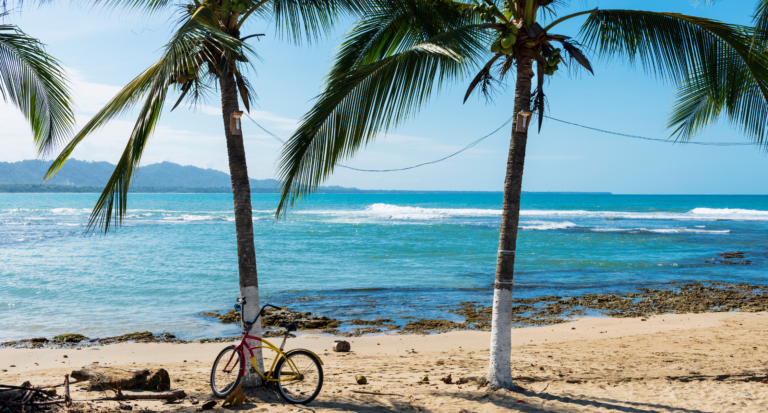Central Valley, Costa Rica: What's Covered
Costa Rica’s highland heartland sits 800-1,500m elevation offering a spring-like climate between San José and three volcanic parks. Poás features a 1.5km-wide active crater requiring advance reservations; Irazú shows both oceans on clear days. Coffee plantations demonstrate seedling-to-cup processing across volcanic slopes. Rental cars access colonial towns Sarchí, Cartago, and Orosi Valley within 30-45 minutes on well-maintained roads.
Quick Facts:
- 2-4 days cover volcanoes, coffee tours, and colonial heritage
- Green season brings sunny mornings, afternoon showers starting 2-3 PM
- Temperatures drop 10-15°F at volcano elevations—pack layers
- SJO airport in Alajuela provides immediate valley access
- Regional weather stays moderate year-round
Top 3 Experiences:
- Poás Volcano – Active crater lake, arrive 7-8 AM before clouds
- Coffee Tours – Doka Estate or Finca Rosa Blanca showing harvest-to-cup
- Orosi Valley Loop – Colonial church, Lake Cachí, authentic hot springs
Perfect base for Costa Rica planning before the beaches. Braulio Carrillo connects to the Caribbean coast.
If you need any help with a Costa Rica car rental, contact us now!
Beyond the beaches and rainforests that draw most visitors to Costa Rica lies a region of extraordinary beauty and diversity—the Central Valley. While many travelers rush through on their way to coastal destinations, this highland heartland offers volcanic wonders, coffee plantations, colonial towns, and cultural experiences that shouldn’t be missed.
Those who take time to explore this region discover some of their most authentic and memorable experiences.
Nestled between volcanic mountains at elevations of 800-1,500 meters (2,600-4,900 feet), the Central Valley enjoys a perpetual spring-like climate that has made it home to two-thirds of Costa Rica’s population. This guide shares local knowledge to help you experience the rich tapestry of attractions beyond San José that make this region special.
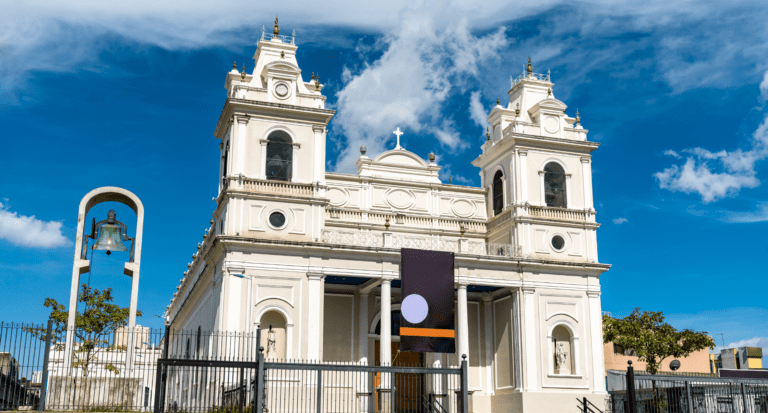
What Makes the Central Valley More Than Just San José?
While San José anchors the region as the capital city (covered in detail in our San José, Costa Rica: Complete Capital City Guide for Travelers), the Central Valley encompasses much more.
The surrounding provinces of Alajuela, Heredia, and Cartago each bring distinct character to the region. You’ll find three major volcanic national parks with unique features and ecosystems. Historic towns preserve colonial architecture and traditional crafts that have been passed down for generations.
Rolling hillsides covered with coffee plantations produce world-renowned beans that put Costa Rica on the global coffee map. Cloud forests and watersheds protect extraordinary biodiversity right in the country’s heartland.
How Quickly Does Urban Turn to Rural?
The dramatic transition from urban environments to rural countryside happens remarkably quickly. Within 30 minutes of leaving downtown San José, you can be surrounded by pastoral landscapes, coffee plantations, and sweeping mountain vistas.
It’s this proximity that makes the Central Valley perfect for day trips when you want variety without long drives.

When Should You Visit the Central Valley?
Unlike coastal regions with distinct wet and dry periods, the Central Valley’s higher elevation creates pleasant temperatures year-round with more moderate seasonal variations.
What’s the Dry Season Like Here?
The dry season (December-April) brings reliable sunshine and minimal rainfall—perfect for volcano visits and outdoor exploration. While this coincides with Costa Rica’s high tourist season, the Central Valley never experiences the crowding seen at beach destinations.
February and March showcase the Central Valley’s remarkable flowering trees. Look for the bright yellow cortez amarillo, purple jacarandas, and pink tabebuias that transform the landscape into a colorful canvas. It’s a spectacular photo opportunity missed by visitors focused only on the green season.
Why Might You Prefer Green Season?
The green season (May-November) typically follows a predictable pattern: gloriously sunny mornings followed by afternoon showers. By planning outdoor activities before midday and cultural visits for the afternoon, you’ll rarely have your itinerary disrupted.
During the green season, rain typically begins around 2-3 PM in the Central Valley. The initial downpour often gives way to a light drizzle or clears entirely by early evening, allowing for comfortable dining and evening activities.
September and October bring the heaviest rainfall to Costa Rica’s Pacific coast, but the Central Valley often remains comparatively drier. If visiting during these months, consider making the Central Valley a larger portion of your itinerary.
Learn more about the advantages of visiting during this time in our Visiting Costa Rica in Green Season: Pros and Cons guide.
Which Volcanoes Can You Actually Visit?
The Central Valley’s landscape has been shaped by volcanic activity, resulting in fertile soil, dramatic terrain, and several accessible volcanic national parks.
Is Poás Volcano Worth the Early Wake-Up?
Absolutely. Just an hour from the Central Valley, Poás features one of the largest active crater lakes in the world. The milky blue sulfuric lake creates a striking contrast against the barren moonscape surrounding it.
On clear days, the views into the 1.5-kilometer-wide (almost a mile) crater are unforgettable.
Essential visitor information:
- Visit early (7:00-8:00 AM) for the clearest views before clouds roll in
- Reservations are required through the SINAC website
- Time at the crater viewpoint is limited to 20 minutes for safety
- Temperatures at this elevation can be 10-15°F cooler than in the valley
After visiting the main crater, follow the short trail to Lake Botos—a water-filled extinct crater surrounded by cloud forest vegetation. This peaceful crater lake offers a stark contrast to the active main crater and is often overlooked by visitors.
Check local news updates to verify the park is open before setting off. Volcanic activity sometimes leads to the park’s closure.
Can You Really See Both Oceans from Irazú?
As Costa Rica’s highest active volcano (3,432 meters/11,260 feet), Irazú offers breathtaking panoramic views. On exceptionally clear days, visitors can indeed see both the Caribbean and Pacific Oceans simultaneously.
The main crater contains a striking emerald-green lake that occasionally changes color with volcanic activity.
The drive to Irazú takes you through prime agricultural land where the cool climate and volcanic soil create perfect conditions for growing potatoes, onions, and strawberries. Stop at roadside stands for the freshest produce and strawberry treats like empanadas de fresa (strawberry turnovers).
Take a sweater and rain jacket as temperatures drop significantly at this elevation.
What Makes Barva Volcano Different?
Less visited than its more famous neighbors, Barva Volcano in Braulio Carrillo National Park offers a more wilderness-oriented experience. The dormant volcano features multiple craters and lagoons surrounded by pristine cloud forest teeming with wildlife.
The hike to Barva’s crater and lakes is challenging but rewarding, taking you through changing ecosystems and offering excellent birdwatching. The trail is less developed than those at Poás or Irazú, providing a more authentic nature experience for those willing to put in the effort.
How Does Costa Rica Turn Coffee Beans into Liquid Gold?
The Central Valley’s volcanic soil, elevation, and climate create ideal conditions for growing some of the world’s finest coffee. Experiencing a coffee tour provides insights not just into agriculture, but into Costa Rican history, culture, and identity.
Which Coffee Tours Are Worth Your Time?
Doka Estate: Located on the slopes of Poás Volcano, this traditional plantation shows every step of the process from seedling to cup. Their water-powered wet mill, declared a Historical and Architectural Heritage site, has operated since the 1920s and offers a glimpse into traditional processing methods.
Finca Rosa Blanca: This organic coffee farm doubles as a luxurious boutique hotel. Their specialized tour focuses on sustainable practices and how elevation affects coffee flavor. The tasting session helps you understand the nuanced flavor profiles of beans grown at different elevations within the plantation.
Café Britt: While more commercial and theatrical, Britt offers an entertaining introduction to Costa Rican coffee history and cultural significance through interactive presentations and comprehensive tastings of various regional beans.
What Do Different Elevations Mean for Coffee Flavor?
Costa Rican coffee typically features bright acidity, medium body, and notes of chocolate, nuts, and citrus. When comparing coffees from different regions, note how higher elevations tend to produce more complex, acidic profiles while lower elevations create softer, nuttier flavors.
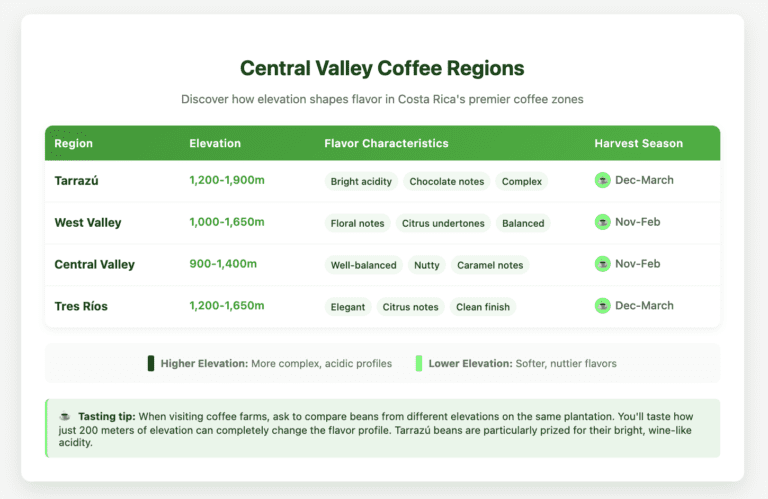
How Do Locals Actually Drink Their Coffee?
To experience coffee like a local, try preparing it using a traditional chorreador—a wooden stand with a cloth filter. This method, still used in most Costa Rican homes, produces exceptionally clean-tasting coffee without the bitterness that comes from electric brewers.
Order it black or with hot milk on the side, never with flavored syrups or whipped cream.
What Other Natural Attractions Should You Visit?
Where Can You See 3,000 Orchid Species?
For more than one hundred years, Lankester Botanical Gardens has researched and cultivated tropical flora, primarily orchids. Visitors have the opportunity to enjoy the sight and often delicate scents of more than 3,000 plants.
Costa Rica’s only Japanese garden is located at Lankester, complete with a lily pond and bamboo. It was donated by the Japanese government in 2009.
Can You See Five Waterfalls in One Day?
Visiting La Paz Waterfall Nature Park enables visitors to see more than 100 animals in the nature refuge including monkeys, sloths and big cats. You’ll also observe five waterfalls from the two miles of trails through rain and cloud forests.
The Butterfly Observatory, Hummingbird Gardens and Frog Exhibit help visitors see some of Costa Rica’s smaller animals up close.
Which Colonial Towns Are Actually Worth Visiting?
Beyond natural attractions, the Central Valley preserves Costa Rica’s colonial heritage and traditional crafts in several charming towns.
Why Is Sarchí Famous for Painted Carts?
This charming small town is renowned as Costa Rica’s craft capital, famous for its brightly painted oxcarts and wooden handicrafts. Traditionally used to transport coffee beans from the highlands to the coast, oxcarts evolved into an intricate art form with designs unique to different regions.
For authentic handcrafted souvenirs, visit Eloy Alfaro Fabrica de Carretas, a traditional workshop using water-powered machinery since the early 1900s. You can watch artisans hand-painting pieces and find everything from small decorative items to full-sized furniture.
Wooden and leather rocking chairs are popular purchases and can be shipped to the US for a nominal cost.
Sarchí is home to the world’s largest oxcart, a colorful national monument celebrating this important symbol of Costa Rican cultural heritage.
What’s Special About Grecia’s Metal Church?
This small agricultural town is famous for its unusual metal church, Iglesia de la Nuestra Señora de las Mercedes. The unique red metal structure was prefabricated in Belgium and shipped to Costa Rica in pieces during the late 19th century.
Visit El Mirador de Grecia for sweeping views of the Central Valley. On clear days, you can see several volcanoes and the expansive valley stretching toward San José.
Take a couple of hours to view the residents of Rescate Wildlife Rescue Center which houses native and exotic animals rescued from all over the country. Support this worthy cause while seeing a wide range of animals from big cats and monkeys to tapirs and crocodiles. Open 365 days a year from 9:00am to 5:00pm.
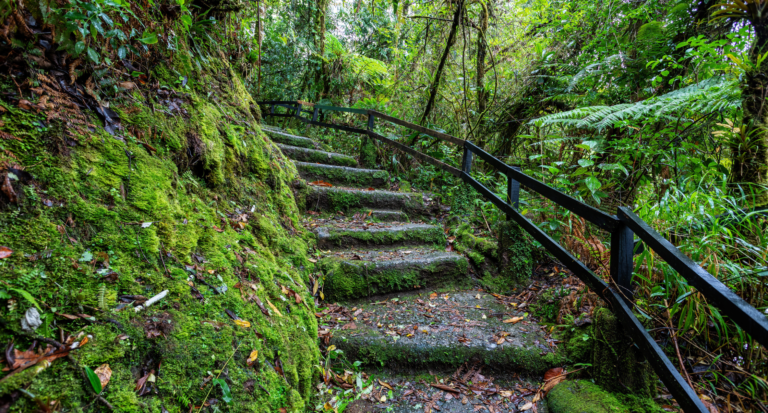
What Makes Each Provincial City Unique?
Why Is Heredia Called the City of Flowers?
Just five miles from the country’s capital, Heredia is known as “City of Flowers” due to the abundance of colorful flowers in the gardens and parks around the city. There’s a buzz to the city as it’s the location of many of the country’s universities, so the center is full of cute coffee shops and cheap eateries.
Visit the Museum of Popular Culture to learn about Costa Rica’s cultural history by touring the 130-year house to see traditional crafts from candle making to logfire cooking.
Nearby San Joaquin de Flores comes alive during Holy Week when the whole town comes out to reenact the stations of the cross and the resurrection in costume.
What Religious Site Draws a Million Pilgrims?
Just 25 kilometers east of San José, Cartago served as Costa Rica’s capital until 1823 and the traditional buildings pay testament to its past. The quaint city is centered around the magnificent Basílica de Nuestra Señora de los Ángeles, home to Costa Rica’s patron saint “La Negrita,” a small black Madonna statue.
If visiting in early August, you might witness the annual romería (pilgrimage), when over a million Costa Ricans walk from various parts of the country to visit La Negrita. Many complete the final kilometer on their knees as an act of devotion or thanksgiving.
Nearby stalls sell small metal offerings in the shape of body parts that believers pin to a board when they are praying to La Negrita for help with a health issue.
The Ruins of the Parish (Las Ruinas de la Parroquia) in central Cartago preserve the remains of an unfinished church repeatedly damaged by earthquakes. Now maintained as a peaceful park, the ruins provide a tangible connection to the region’s seismic activity and colonial past.
Why Does Alajuela Have the Best Mangoes?
Costa Rica’s second city is home to the international airport but beyond the practical logistics, Alajuela offers visitors an authentic urban area with charming parks and rich history. Known as the ‘City of Mangoes’ due to many mango trees lining the city streets, it is located just 12 miles from San Jose.
Boutique hotels provide alternatives to the cookie-cutter chain accommodation near the airport while being close enough to have convenient options to stay after landing or before departure.
Discover the history of Juan Santamaria who is the hero of Costa Rica’s fight against the Filibusters in 1856-57 at the Juan Santamaria Historical Cultural Museum.
The city center is easy to stroll around and it’s worth stepping into the renovated Our Lady of the Pillar Cathedral next to the park to admire the elegant building’s three domes and artwork. Originally constructed in 1782, the painted ceilings and highly ornate dome embellishments are a breathtaking glimpse into Costa Rica’s strong Catholic tradition.
Which Lesser-Known Spots Do Locals Love?
After years of exploring the Central Valley, several lesser-known attractions rarely make it into standard guidebooks but offer authentic experiences.
Is Orosi Valley Costa Rica’s Most Picturesque Landscape?
One of Costa Rica’s most picturesque landscapes, the Orosi Valley combines natural beauty with colonial history. The valley is home to the oldest still-functioning church in Costa Rica (built in 1743) and the ruins of one of the country’s oldest churches in Ujarrás (dating to the 1580s).
The loop around Lake Cachí and through the Orosi Valley offers some of the most beautiful countryside views in Costa Rica. Allow at least half a day to enjoy the numerous viewpoints, historic sites, and coffee stops along the way.
While Arenal is famed for hot springs, Orosi has several thermal pool facilities where you’ll soak alongside local families rather than tourists. Hacienda Orosi offers a more authentic (and affordable) hot spring experience than the elaborate resort complexes in Arenal with the additional attractions of birdwatching, a coffee plantation hike and a family-friendly farm.
Less than an hour outside of Cartago, the little known Tapanti National Park offers El Salto waterfall and four trails to explore the diverse flora including many orchid species across five different life zones. Keep your eyes peeled for monkeys, coatis and even tapirs.
Does Atenas Really Have the World’s Best Climate?
Famed for having the world’s best climate, Atenas has attracted expats for years due to the year-round spring temperatures and its ideal positioning between the capital and beach towns. The pace is slow today but visitors are reminded of the town’s history as a stop on the oxcart route between the capital and ocean ports with statues and other references to the coffee trade.
La Casita de Cafe is the perfect breakfast location serving great coffee with views over coffee plantations right to the ocean.
Las Minas del Aguacate are a series of cascades from a river flowing near an abandoned gold mine and offer visitors a refreshing dip after a rocky hike.
Where Can You Spot Quetzals Without the Crowds?
This highland region south of San José produces some of Costa Rica’s most prized coffee yet remains relatively untouched by mass tourism. The main towns of Santa María de Dota, San Marcos de Tarrazú, and San Pablo de León Cortés offer glimpses of traditional rural Costa Rican life amid breathtaking mountain scenery.
From December through April, the cloud forests around San Gerardo de Dota provide one of Central America’s most reliable locations to spot the resplendent quetzal. Early morning guided hikes offer the best chances to see these magnificent birds and provide visitors with a welcome alternative to the tourist magnet of Monteverde.
The cool climate of Los Santos is perfect for trout farming. Small family-run restaurants throughout the region serve fresh trout prepared in traditional ways—a delicious local specialty rarely found in tourist areas.
Carnival Pableño is celebrated annually on January 25th in San Pablo de León Cortés with street parades, music concerts and regional cuisine for an authentic local celebration.
What’s the Deal with Zarcero’s Living Sculptures?
In the small town of Zarcero, local artist Evangelisto Blanco spent decades transforming cypress trees into whimsical sculptures from helicopters to teletubbies. The topiary garden sits in front of the picturesque pink and white church, creating a uniquely photogenic scene that combines art and nature.
Visit in the morning when the light is soft and the gardens are typically less crowded. The contrast between the meticulously shaped topiaries and the church’s architecture makes for stunning photos.
Don’t miss out on the local ‘queso palmito’ which can be purchased at street side stalls and is eaten by peeling strips from the white cheese ball.
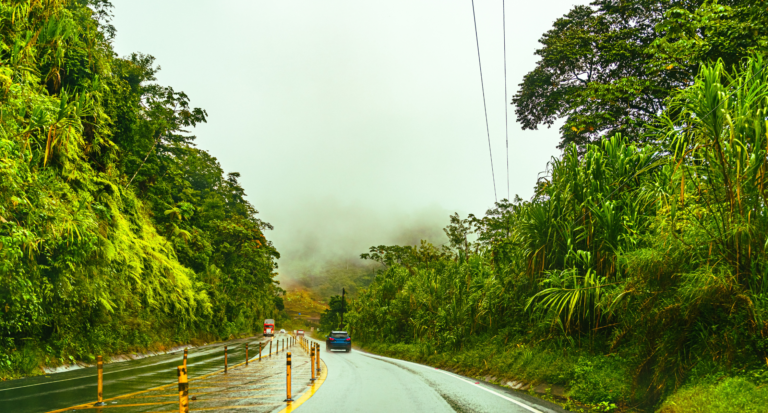
How Should You Get Around the Central Valley?
The Central Valley’s well-developed road network makes it relatively easy to explore, though each transportation option offers different advantages and limitations.
Why Does a Rental Car Make Sense Here?
Renting a car provides maximum flexibility for exploring the Central Valley, especially for reaching more remote attractions and viewpoints. Unlike some other regions of Costa Rica, most roads in the Central Valley are paved and well-maintained, though mountain routes can be winding.
Key driving considerations:
- GPS or offline maps are essential as street signs are limited
- In the San José metropolitan area, rush hour (7-9 AM and 4-7 PM) can add significant time to your journey
- Standard vehicles are suitable for most Central Valley destinations—4WD is only necessary for the most remote areas
- Fuel stations are plentiful throughout the region
For detailed information on navigating Costa Rica’s roads safely, see our Driving in Costa Rica: What to Expect on the Roads guide.
Can You Really Use Public Buses?
Costa Rica has an affordable bus network that connects all major towns in the Central Valley. Buses from San José to Alajuela, Heredia, and Cartago run frequently (every 10-15 minutes) and cost less than $1.
For smaller towns, check schedules carefully as some routes may only operate a few times daily. Buses depart from different terminals around San José based on their destination. Most buses are comfortable but not luxurious—air conditioning is inconsistent.
Bus fares are incredibly economical, typically ranging from $0.50-$3 for destinations within the Central Valley. Consider using buses for straightforward point-to-point travel, even if you have a rental car for other portions of your trip.
When Do Tours Make More Sense?
For specific attractions like volcano visits or coffee plantations, organized tours with transportation included can be the most hassle-free option if costly.
For destinations within the Central Valley, day tours are often more economical than private transfers, with the added benefit of knowledgeable guides who enhance your understanding of the sites.
For a more detailed comparison of transportation options throughout Costa Rica, see our guide to Transportation in Costa Rica: Shuttle, Rental Car or Private Driver?
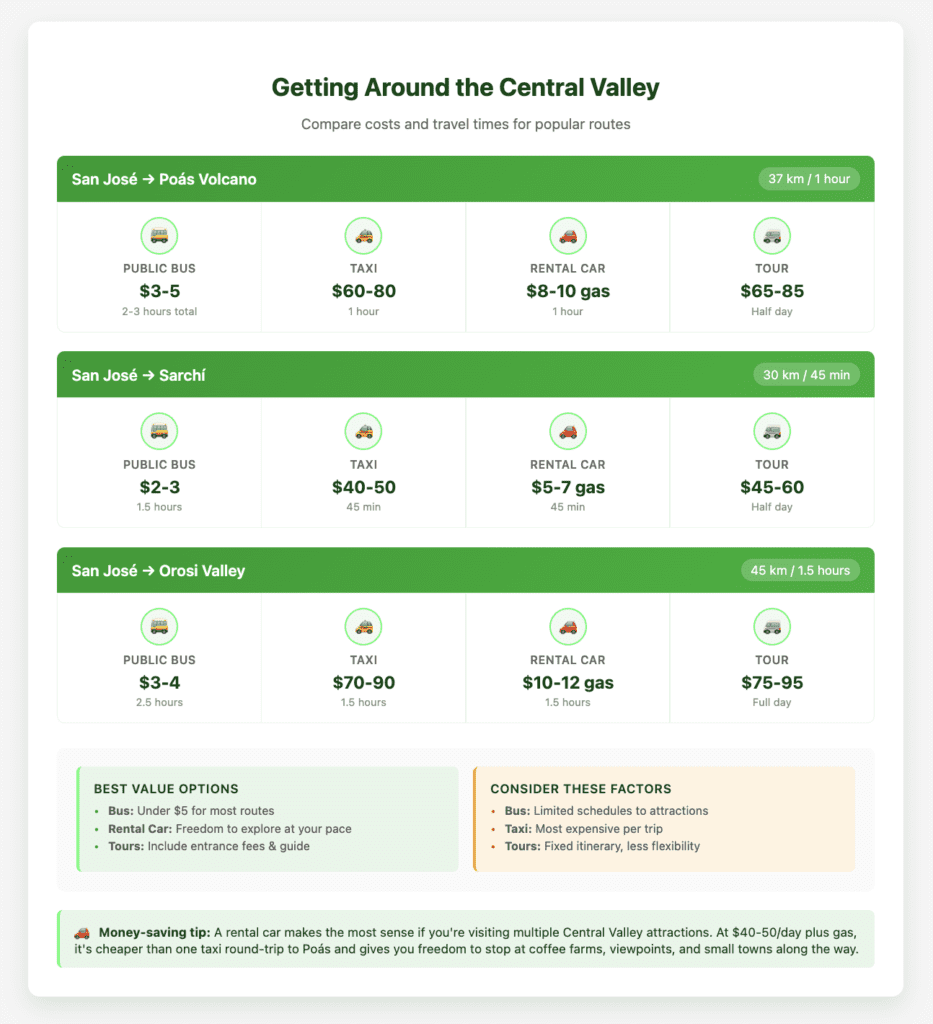
Where Should You Stay in the Central Valley?
The Central Valley offers diverse accommodation options beyond just San José. Consider these alternatives for a more authentic experience.
Want Mountain Views with Your Morning Coffee?
Heredia Mountains: Boutique hotels and coffee plantation stays offer cooler temperatures and spectacular mountain views just 30-45 minutes from San José.
Orosi Valley: Thermal hot spring hotels and lodges with spectacular valley views provide a peaceful alternative to the busier Arenal hot springs region.
Los Santos Region: Rural lodges and coffee farms offer authentic immersion in Costa Rican countryside life with an emphasis on sustainability and nature.
Many coffee plantations have transformed historic buildings into boutique hotels where you can learn about coffee production while enjoying luxury accommodations. Finca Rosa Blanca and Chayote Lodge exemplify this unique lodging experience.
Prefer Small Town Charm?
Alajuela: More relaxed than San José with a charming central park, excellent restaurants, and convenient access to Juan Santamaría International Airport.
Atenas: Often claimed to have “the best climate in the world,” this small town offers beautiful views, a traditional lifestyle, and growing expat community.
Grecia: A picturesque agricultural town with its famous metal church, excellent year-round weather, and authentic local markets.
For more information about accommodations near the international airport, see our Complete Guide to Juan Santamaría International Airport (SJO).
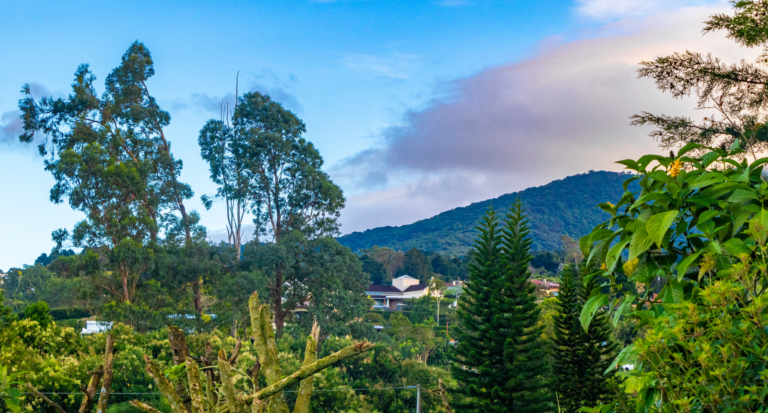
How Many Days Do You Need for the Central Valley?
These focused itineraries help you make the most of your time in the Central Valley without duplicating experiences you might have elsewhere in Costa Rica.
Got Two Days? Here’s Your Best Route
Day 1: Natural Wonders
- Early morning: Drive to Poás Volcano National Park (arrive by 8:00 AM for best visibility)
- Mid-morning: Visit Doka Coffee Estate for a tour and tasting
- Afternoon: Explore La Paz Waterfall Gardens
- Evening: Overnight in Alajuela or the Heredia mountains
Day 2: Cultural Heritage
- Morning: Visit the colonial city of Cartago, including the Basílica and ruins
- Midday: Drive the scenic Orosi Valley loop, stopping at viewpoints and the colonial church
- Afternoon: Visit the artisan town of Sarchí to see traditional crafts being made
- Evening: Return to your accommodation or continue to your next destination
Have Four Days? Add These Experiences
Days 1-2: Follow the two-day itinerary above
Day 3: Irazú and Southern Valley
- Morning: Visit Irazú Volcano for panoramic views
- Midday: Lunch at a traditional restaurant in Cartago
- Afternoon: Explore Lankester Botanical Gardens and its incredible orchid collection
- Evening: Overnight in the Orosi Valley at a hot springs hotel
Day 4: Off the Tourist Trail
- Morning: Early start to Zarcero to see the topiary gardens
- Midday: Continue to the Los Santos region for a taste of rural Costa Rica
- Afternoon: Coffee tour and tasting in the highlands
- Evening: Return to your accommodation or continue to your next destination
For more extensive itinerary options that combine the Central Valley with other regions of Costa Rica, see our Planning the Ultimate Costa Rica Vacation Guide.
What Practical Tips Do You Need for the Central Valley?
How Do You Handle the Airport Location?
Juan Santamaría International Airport (SJO) is located in Alajuela, providing convenient access to the Central Valley. For detailed information on navigating this gateway, refer to our Choosing the Right Costa Rica Airport: Your Gateway to Paradise guide.
Most Central Valley roads are well-maintained and paved, though mountain routes can be winding with occasional fog, especially around volcano areas.
Costa Rica uses a unique address system based on landmarks rather than street names and numbers. “300 meters west of the church” is a typical address format. GPS or offline maps are essential for navigation.
What About Weather Changes at Different Elevations?
Temperature changes can be significant as you move between different elevations in the Central Valley. Layer your clothing accordingly.
Volcano areas often clear by mid-morning after early mist dissipates. During the green season, carry a light rain jacket for predictable afternoon showers. The higher altitude means stronger sun exposure even on cloudy days—don’t forget sunscreen.
If visiting during the green season (May-November), plan outdoor activities for the morning hours when skies are typically clear. Schedule indoor activities like museum visits or shopping for the afternoon to avoid rain disruptions.
For comprehensive information about regional weather patterns throughout Costa Rica, see our guide to Costa Rica’s Regional Weather Patterns.
How Do You Experience the Central Valley Like a Local?
For an authentic experience, visit a local café in a small town rather than international chains. Order a “café chorreado” (traditional drip coffee) and watch how locals prepare it.
Central Valley towns have weekly farmers’ markets (ferias) where locals buy fresh produce. Saturday mornings in smaller towns offer glimpses of authentic Costa Rican life and the opportunity to sample local specialties.
Look for “sodas” (small family-run restaurants) rather than tourist-oriented establishments. A “casado” (married) plate offers the most traditional meal: rice, beans, protein, plantains, and salad.
In small Central Valley towns, the central park (parque central) comes alive in the evenings as locals gather to socialize. Join them for a peaceful evening observing authentic community life.
Ready to Explore Costa Rica's Heartland?
The Central Valley offers much more than just a gateway to Costa Rica’s beaches and rainforests. With its volcanic wonders, coffee heritage, colonial towns, and authentic cultural experiences, this region deserves dedicated exploration.
Whether you’re seeking adventure at volcanic craters, learning about coffee production at historic plantations, or discovering the artisan traditions of small towns, the Central Valley provides a perfect introduction to the many facets of Costa Rican life.
By taking time to explore beyond San José, you’ll discover a side of Costa Rica that many visitors miss—one where daily life continues much as it has for generations, despite rapid development elsewhere in the country. From misty volcano summits to quiet colonial plazas, the Central Valley invites you to slow down and appreciate the authentic heart of Costa Rica.
Your Central Valley Action Plan:
- Reserve your Poás volcano visit online (they sell out!)
- Rent a car for maximum flexibility exploring mountain roads and small towns
- Pack layers—temperatures vary significantly with elevation
- Plan morning activities outdoors, afternoon museum visits during green season
- Try local sodas instead of tourist restaurants for authentic meals
¡Pura vida!
